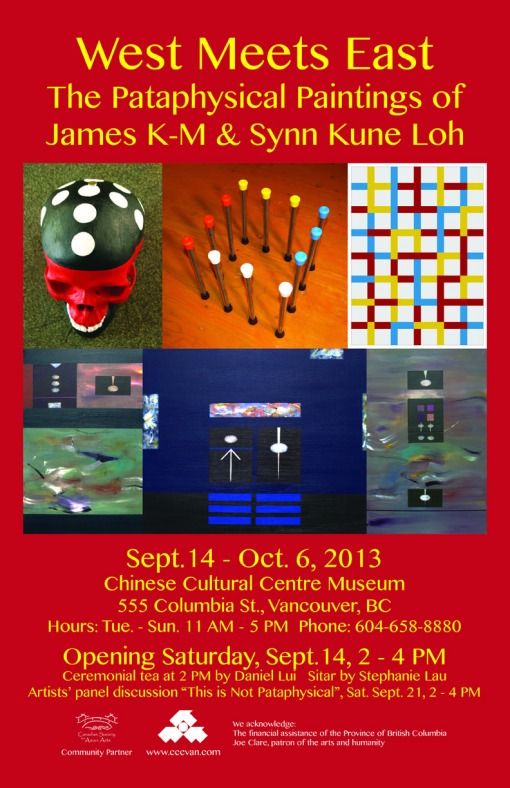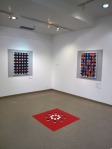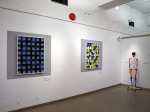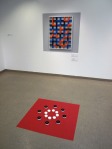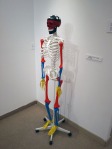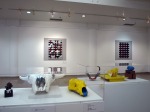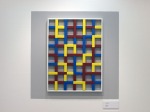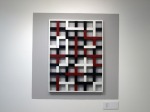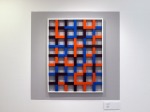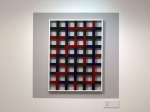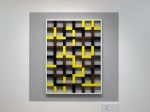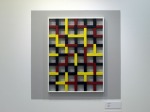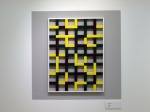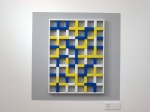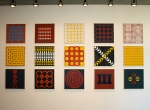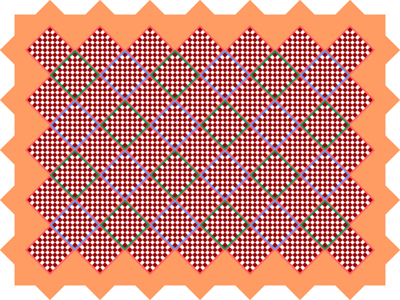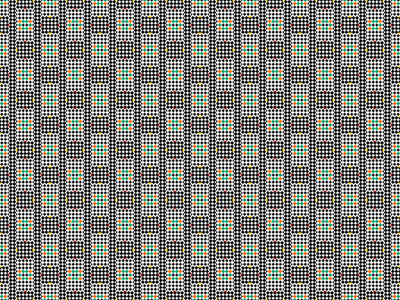appropriation
August 11, 2013
The Pataphysical Paintings of James K-M & Synn Kune Loh
Posted by James K-M under abstract, Abstract sculpture, appropriation, art, canada, canadian, geometric, kabbalah, metaphysics, op art, Paintings, pataphysical, pataphysics, pattern, pictograph, pictographic, pop art, primal, vancouver, vortex, vorticismLeave a Comment
August 1, 2008
Cave Paintings at SFU
Posted by James K-M under 2012, abstract, appropriation, art, canada, canadian, geometric, kabbalah, metaphysics, op art, Paintings, pop art, primal, recent paintings, vancouver1 Comment

Image: Hearing Bone (detail), stain and acrylic on plywood, 24” x 24,” 2007
James K-M: Cave Paintings, September 2 – November 22, 2008.
Opening: Friday, September 5, 8 – 9 pm. Open daily during campus hours.
Please join us for the exhibition opening at the Teck Gallery, SFU Vancouver Campus, 515 West Hastings St, Vancouver, BC. The artist will be in attendance. Opening remarks at 8:30 pm.
Artist talk: Monday, September 15, 7pm
The artist will present a talk titled “Is There Anything Old Here?”
Room 1600, SFU Vancouver campus
T: 778-782-4266 W: sfu.ca/gallery E: gallery@sfu.ca
James K-M is a Vancouver-based painter who has, since 1983, created a vast series of hard-edge, optically charged works. These paintings reference primordial languages, the linkages between aural and visual phenomena, as well Op Art—a key historical avant-garde movement. The question of how the social is contained within abstraction has been raised in many arenas over the twenty-five years since the first of these paintings were made. This exhibition addresses that societal role, while querying the rationales that continue to exist for new work in hard-edge abstraction. – Bill Jeffries, August, 2008
This exhibition is accompanied by a 24-page catalogue with essays by Eric McLuhan and Bill Jeffries:
Cave Paintings? by Eric McLuhan (.pdf)
Empathy for Abstraction by Bill Jeffries (.pdf)
“Out of extremely objective systemization comes extreme subjectivity”
Bill Jeffries, SFU Gallery Curator
September 21, 2007
Cave Paintings
Posted by James K-M under 2012, abstract, appropriation, art, canada, canadian, geometric, metaphysics, op art, Paintings, pop art, primal, recent paintings, vancouver[4] Comments
The Mayan calendar is due to end October 28, 2011 (or at the winter solstice 2012 depending on interpretation) and is considered to signify an ‘end of time’ as we know it. What an ‘end of time’ means exactly is uncertain but there is some agreement that a significant transitional shift of consciousness is coming and is already underway. How does one prepare for this transition? Only by cultivating one’s own patterns of abstract interconnectedness.
In my paintings, cross cultural appropriation can allude to Native beadwork, old floor tiling, post New York school abstraction or minimalism, a board game without pieces (since the work moves without them), a Navaho blanket, or Aztec or Mayan sacred geometry. These aspects represent appropriated traditions that don’t usually coexist and a collision of cultures that are also somehow resonant with each other. Yet my work remains within the tradition of Western abstract painting, constrained by a square piece of plywood interacting with a stained grainy surface which reveals a sentient conscious unknown, superimposed by a contemporary abstract figure.
The feel of the cave — the cave.
From a cave they looked out on the world,
And struggled to understand,
And slowly the flicker of their intelligence
Grew and consumed the dusk with their mind
~ Mark Rothko, 1920s
February 9, 2007
Curator Statement: The Spiritual in Digital Art
Posted by James K-M under abstract, appropriation, art, digital paintings, geometric, metaphysics, Paintings, primal, vancouver[3] Comments
Curator Statement for Digitalis 2: The Spiritual in Digital Art
James K-M, 2003
Mat, pigmented ink on canvas, 2003
It has always seemed to me that art comes from or is destined for a place beyond itself. Mystics call this place a realm beyond thought and for me this realm represents a viable, visual, pre-literate, multi-sensory and spiritual path for all to interface with. All the works in this exhibition evoke this metaphysical realm and represent a diversity of strategy to get at or interface with that place beyond thought, time and art.
Digitalis 2 is our second exhibition of digital print and it is the mission of the Digitalis Digital Art Society in curating this exhibition to explore what the digital world has to offer the analogue world. Hence our interest in the traditional picture hanging on a wall. Unlike Digitalis 1, which was held at Moon Base Gallery in Vancouver in December 2001, we have included a small selection of work that resides only in the computer such as CD-ROMs, a DVD-Video and Web sites. The two worlds of digital/computer media and analogue/print media can certainly co-exist and complement each other very well, but our interest here is in how the first can propel the second forward, carrying as much tradition with it as the medium can handle.
Some of the work in this exhibition is not what you would call technically accomplished but most is. Some artists are still in transition and dependent on how well they can understand a Photoshop manual, how large a paper size their home ink jet printers can take or how much RAM they can afford. Others have day jobs where they teach the software they create with or otherwise are employed or self-employed creating commercial Web sites, CD/DVD-ROMs, CD-Audio, DVD-Videos, printed annual reports, newspaper layout or graphic design and all with software like Photoshop, Illustrator, Quark, Director, Flash, Dreamweaver, Pro Tools, Final Cut Pro, After Effects or DVD Studio Pro. In the end though, it is the inspiration, insight, vision and spiritual struggle in any artist that drives the software we use and which is represented by the work in this show.
This exhibition is about the spiritual in digital art. This is not a show about the existential. In selecting the work I simply tried to sense a spiritual visual communication that makes contact with the life of forms, the mysterious realm beyond thought, of no-thingness and a depth of simultaneous play, radiance, introspection, light and darkness. None of this work is necessarily about the computer or the software used. What we have here is the unknown interfaced with a marvelous convergence of everything our civilization has collected; a convergence of oil painting, photography, Pop Art, ritual, male and female spirit, technology, dream communication, criticism and cultures.
Rise, pigmented ink on canvas, 2003
January 21, 2007
A Metaphysics of Appropriation
Posted by James K-M under 2012, abstract, appropriation, art, early work, geometric, metaphysics, Paintings, primal, recent paintings1 Comment
A Metaphysics of Appropriation
James K-M, 2007
The Mayan calendar is due to end at the winter solstice 2012 and is considered to signify an ‘end of time’ as we know it. What an ‘end of time’ means exactly is uncertain but it does seem that a significant transitional shift of consciousness is coming and is already underway. How does one prepare for this transition? Only by cultivating one’s own patterns of abstract interconnectedness.
In my recent paintings, cross cultural appropriation can allude to Native beadwork, old floor tiling, post New York school abstraction or minimalism, a board game without pieces (since the work moves without them), a Navaho blanket, or Aztec or Mayan sacred geometry. These aspects represent appropriated traditions that don’t usually coexist and a collision of cultures that are also somehow resonant with each other. They coexist here as metaphysical appropriations beyond the kind of appropriation that is gestural and ironic. Colours are intuitively appropriated from 20th Century war uniforms, hunting lodge flags, badges or blankets. This simultaneity can be referred to as a metaphysics of appropriation. Yet my work remains within the realm of Western abstract painting. It is constrained by the square piece of plywood which interacts with a stained grainy surface revealing a sentient conscious unknown superimposed by a contemporary abstract figure.
As well, the following thoughts are expressed in these most recent paintings. While the art community and popular culture aficionados have been intrigued by the novelty of appropriation of visual culture, there has been a 2nd kind of appropriation occurring simultaneously. Much like the secret 2nd transport machine in the film Contact that actually does reach its extra-terrestrial destination, this 2nd kind of appropriation can be described as non-ironic, multi-ethnic, abstract, metaphysical and much subtler and more intuitive in the way it recycles visual culture. Borrowing from across cultures as well as across time to express more than just a summation of Western visual culture, appropriation(2nd) expresses a summation and a connectivity that has something for everyone.
This is the secret, subtle, simultaneous 2nd destination or goal that appropriation gestures toward and is the escape from the cyclical limitations of recycled visual culture. Rather than recycling or cycling visual culture, appropriation(2nd) spirals visual culture. Both are abstract, metaphysical and geometric processes, but while the first nervously waits for a new cycle to announce its demise, appropriation(2nd) spirals into ever more profound levels of play and abstract interconnectedness where there are no boundaries, except those defined by the inherent language of the medium and tools that the artist chooses to play with.
Cultural appropriation occurs regardless of how explicit we make it and metaphysical truth will always be replayed in a contemporary style in any age. As long as the contemporary spirals along from age to age we can never say that it’s all been done.
My working method is to go to Home Depot and have them cut a sheet of ½” plywood into 8 squares of 2’ x 2’. On each square I apply two coats of a single colour of wood stain. My current palette of stain is black, white, red, orange, yellow, pthalo blue and pthalo green. My current palette of acrylic is the same but with three shades of red, raw umber and raw sienna.
I find that there are two main advantages to working again with paint (and stain) instead of the digital print. First is that the grain of the plywood surface becomes an important part of the work and second, that I am now able to create a unique subtlety by painting, for example, yellow acrylic on yellow stain, or black acrylic on black stain. Both create a mysterious subtlety that I could never achieve digitally.
My content is geometric, abstract and colourist.
Although I’ve lived in Vancouver since 1983, I grew up in Toronto where I became aware of painters like Ad Reinhardt, Jack Bush, Mark Rothko, Morris Louis, Kenneth Noland, Sonia Delaunay, Arshile Gorky, Piet Mondrian, Barnett Newman and non-abstract painters like Henri Matisse, Paterson Ewan, Emily Carr, Francis Bacon, Frank Auerbach and R.B. Kitaj.
In the late-1970’s I came to know the work of the Neo-Expressionist and TransAvantGarde painters like Julian Schnabel, David Salle, Francesco Clemente and Enzo Cucchi. I consider all of these artists to have a strong metaphysical content and I resonate with this kind of primal expression in all art forms, especially painting. Similarly, I hope that my paintings convey mystery, mysticism and the metaphysical.
